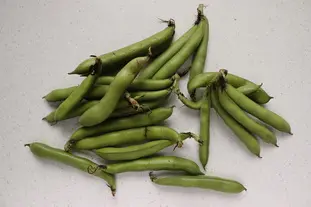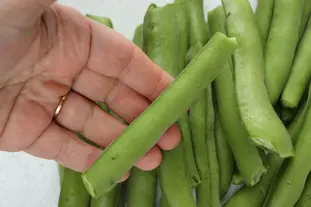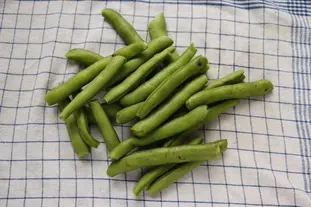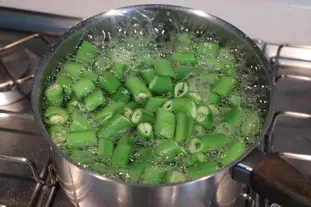Beans in primeur

As I write this, it is the beginning of the short season for fresh beans. If you've never made them before and you're just starting out (and that's a great idea) you'll find that it's a bit time consuming to prepare, you have to shell them once, remove the beans, scald them to remove the skin (and the germ for the purists) and then only use them in a recipe.
It's hard work, but it's delicious...
This being said, there is a little known aspect about beans, they are the so-called "primeur" or "en primeur" beans, which are prepared in a very different and much faster way.
It's hard work, but it's delicious...
This being said, there is a little known aspect about beans, they are the so-called "primeur" or "en primeur" beans, which are prepared in a very different and much faster way.
14 K
Keywords for this post:BeansEarly vegetablesGreen vegetablesPodsLast modified on: June 4th 2022
Beans in primeur
In early season?
This is said of beans at the very beginning of the season, when they are still small, 8-10 cm maximum, and very tender.If you find some of this size, you often have to ask the farmer, it's quite surprising but you should know that everything is eaten in the beans at this time, the beans of course (not very big at this age), but also the pod that contains them.
How to do it ?
The trick is to work them a bit like green beans:
1) We break the 2 ends of the terminal by pulling to remove any wires, but there are very few in general.

2) We wash and dry them.

3) We cut them in small pieces, to your taste.

4) We cook these small pieces as you are used to with other green vegetables, I like to cook them first in English (boiling salted water 3-4 minutes) and then cooled and drained, returned with a knob of butter or a little olive oil.
You will be surprised by the taste, something between snap beans and peas it seems, and the texture, very soft.
Don't hesitate to mix these beans with other vegetables for a varied and colorful dish.
To sum up: You can enjoy early beans, at the beginning of the season, by treating them a bit like green beans, which allows you to eat the whole pod, it is both delicious and very economical.
Lasts posts
Butter vs. grease
We often read in a recipe where a pastry is put into a mould that, just before pouring, the mould should be buttered or greased. But what's the difference between these 2 terms?December 1st 20259055
Getting out of the fridge early
Very often when you're cooking, you need to take food or preparations out of the fridge, to use them in the recipe in progress. There's nothing tricky about this: you just take them out of the fridge and use them, usually immediately, in the recipe. But is this really a good method?November 24th 20251,0585
Who's making the croissants?
When you look at a bakery from the outside, you naturally think that in the bakery, the bakers make the bread, and in the laboratory, the pastry chefs make the cakes. It's very often like that, with each of these professions having quite different ways of working, but sometimes there's also one...November 23th 2025955
Oven height
When we put a dish or cake in the oven, we naturally tend to put it on the middle shelf, and that's what we usually do. But in some cases, this position and height can be a little tricky, so let's find out why.October 8th 20252,6255
The importance of sieving
In recipes that use a fine powder (flour, powdered sugar, etc.), you'll often see the advice to sift before using it. To sift is to pass the powder in question through a sieve (a very fine strainer) before incorporating it into your recipe. It's often advice, but is it really useful?September 3rd 20257,4633
Other pages you may also like
No need to boil gelatin
Gelatin is a magical ingredient for making light, creamy, structured desserts, yet it's often misused in the kitchen. A common mistake in some recipes is the idea that it needs to be boiled for it to work properly, but this is a mistake indeed: gelatin melts at a much lower temperature, around...November 21th 20248,1905
The window-pane test in bread-making
The home bread-makers often ask themselves “Have I kneaded my dough long enough?” . A good question, as dough that is insufficiently kneaded will not rise properly or will fall flat when the top is slashed, which is very frustrating. To know when the dough is ready, one can rely on the length...June 16th 202196 K 23.9
What can I use for blind baking a pastry case?
When it comes to home-made desserts, tarts are always popular. They can be divided into two basic types: those cooked with their filling, such as an apricot and almond cream tart, and those where the filling is added after baking the pastry case, such as a strawberry tart or chocolate tart. For...May 2nd 2017112 K4.5
Divide and weigh dough into regular pieces
When you prepare dough for cupcakes in a pastry shop or bakery, at some point you're going to have to divide it, i.e. cut it into small pieces, which should all have the same weight. Sounds simple enough, but is it really that simple?May 30th 202312 K5
Tranché, dissociated, failed, in short... missed!
When preparing a sauce or a cream, there's always a (small) risk that the creamy preparation you're working on will suddenly separate into two parts of different textures: a liquid part, for example, and a more or less solid part, or even become lumpy. It's terribly frustrating, but we'll see...June 19th 202313 K5
Post a comment or question
Follow this page
If you are interested in this page, you can "follow" it, by entering your email address here. You will then receive a notification immediately each time the page is modified or a new comment is added. Please note that you will need to confirm this following.
Note: We'll never share your e-mail address with anyone else.
Alternatively: you can subscribe to the mailing list of cooling-ez.com , you will receive a e-mail for each new recipe published on the site.









